Hassani S. Mathematical Physics: A Modern Introduction to Its Foundations
Подождите немного. Документ загружается.


27.5
REPRESENTATION
OF
LIE
ALGEBRAS
873
Theremay be someinternalinteractions
between
constituents
of
a (composite)
particle, e.g. between quarks inside a proton,
but
as a whole, the composite will be
interpretedas a singleparticle. Toconstructthe littlegroup, we have to specify a 4-
momentum
Po.We shall considertwo cases:
In
the first case, Po .Po
i'
0, whereby
the particle is deduced to be massive and we can
cheosel'' Po =
(0,0,0,
m). In
the second case, Po . Po = 0, in which case the particle is massless, and we can
choose
Po =
(p,
0, 0,
pl.
We consider these two cases separately.
The
little group (really, the little
Lie
algebra) for Po = (0, 0, 0, m) is obtained
by searching for those rotations that leave
Po fixed. This is equivalentto searching ,
for
Mij's that annihilate (0, 0, 0, m), namely, the solutions to
(MijPo)/ =
(Mij)/r(Po)r
= (Mij)lOm = °
=>
(Mij)1O = 0.
Since
(Mij)1O
=
~iO~j/-~jO~il,
we conclude that (Mij)1O =°if and
onlyifi
i'
°
and j
i'
0. Thus the little group is generated by
(MZ3,
M31,
M12)
which are the
components
of
angular momentum. Thereader may also verify directly that
when
the 4-momentum has only a time component, the Casimir operator W
2
reduces
essentially to the total angular momentum operator. Since we are dealing with a
singleparticle, the total angnlar momentum can only
be spin. Therefore, we have
the following theorem.
27.5.11.
Theorem.
In the absence
of
any interactions, a massive relativisticpar-
ticle is specifiedby its mass m
and
its spin s, the
former
being any positive number,
the latter taking on integer or half-odd-integer values.
The
case
of
the massless particle can he handled in the same way. We seek
those
Mij's that annihilate
(p,
0, 0,
p),
namely, the solutions to
(MijPO)k =
(Mij)kr(PO)'
=
(Mijlkop
+
(Mij)klP
= 0.
The
reader may check that
(MOIPO)k
=
~lkP
-
~OkP,
(MZ3PO)k
= 0,
(M02PO)k
=
~2kP,
(MI2PO)k
=
~2kP,
(MQ3Polk
=
~3kP,
(M13Polk
=
~3kP·
Clearly,
MZ3
is
one
of
the generators
of
the little group. Subtracting the middle
terms
and
the
last
terms
of
each
line, we see that
Moz
-
MI2
and
M03
-
M13
are the
other two generators. Thesehappen to be the components
ofW.
In fact, it is easily
verified that
W
O
= Wi =
MZ3P,
W
Z
= 2p(M13 -
M03),
W
3
= 2p(Moz -
M12).
(27.75)
Therefore, the little group is generated by all the components
of
W. Furthermore,
W
2
has zero eigenvalue for
IVrpo)
when
Po = (p, 0, 0,
pl.
Since
both
Casimir
18We
use unitsin whichc = 1.
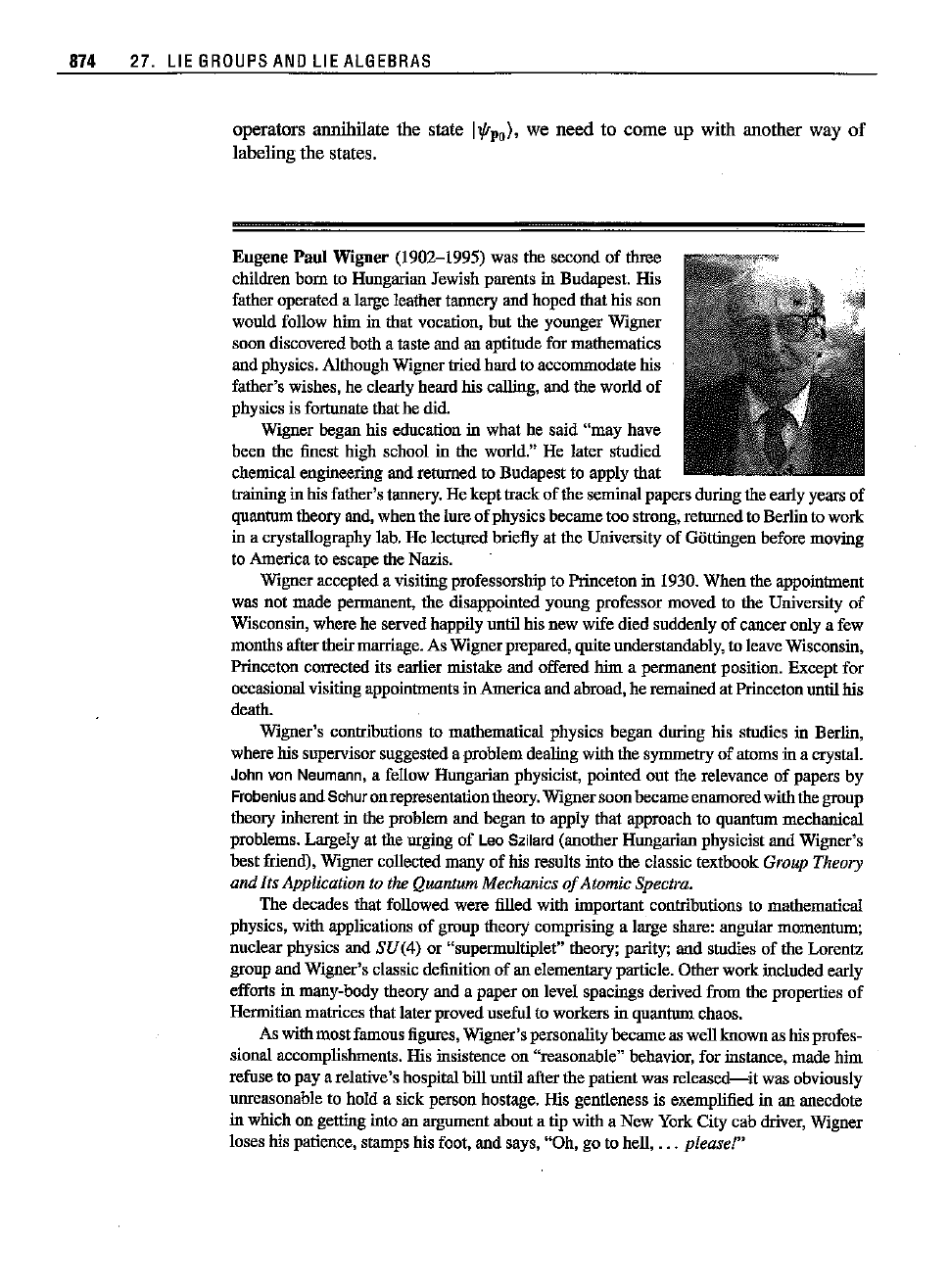
874 27. LIE
GROUPS
AND
LIE
ALGEBRAS
operators annihilate the stale
l1frpo)'
we
need
to
come
up with another way
of
labeling the states.
Eugene Paul Wigner (t902-1995) was the second of three
children born to Hungarian Jewish parents in Budapest. His
father operated a large leather tannery and hoped that his son
would follow him
in that vocation, but the younger Wigner
soon discovered both a taste and an aptitude for mathematics
and physics. AlthoughWigner triedhard to accommodate his
father's wishes, he clearly heard his calling, and the world
of
physicsis fortunatethathe did.
Wigner began his education in what be said
"may
have
been the finest high school in the world." He later studied
chemicalengineeringandreturned to Budapestto apply that
training
in hisfather'stannery. Hekept trackofthe seminalpapersduringtheearlyyearsof
quantumtheory and, when the lure
of
physics
became
too strong, returned to Berlinto work
in a crystallography lab. He lectured briefly at the University
of
Gfittingen before moving
to America to escape the Nazis.
Wigner accepted a visiting professorship to Princeton in 1930.
When
the appointment
was
not
made permanent, the disappointed young professor moved to the University
of
Wisconsin, where he served happily until his new wife died suddenly
of
cancer only a few
months aftertheirmarriage. As Wignerprepared, quiteunderstandably, to leave Wisconsin,
Princeton corrected its earlier mistake and offered
him a permanent position. Except for
occasionalvisitingappointments in America and abroad, he remained at Princetonuntilhis
death.
Wigner's contributions to mathematical physics began during his studies in Berlin,
where his supervisor suggested a problem dealing with the symmetry
of
atoms in a crystal.
John von Neumann, a fellow Hungarian physicist, pointed out the relevance
of
papers by
Frobeniusand Schur on representationtheory. Wignersoonbecameenamoredwiththe group
theory inherent in the problem and began to apply that approach to quantum mechanical
problems. Largely at the urging
of
LeoSzilard (another Hungarian physicist and Wigner's
best friend), Wigner collected many
of
his results into the classic textbook Group Theory
and
Its Application to the Quantum Mechanics
of
AtomicSpectra.
The decades that followed were filled with important contributions to mathematical
physics, with applications
of
group theory comprising a large share: angular momentum;
nuclear physics and
SU(4) or "supermultiplet" theory; parity;
and
studies
of
the Lorentz
group and Wigner's classic definition
of
an elementary particle. Otherwork included early
efforts in many-body theory and a paper on level spacings derived from the properties
of
Hermitian matrices that laterproveduseful to workers in quantum chaos.
As withmostfamous figures, Wigner's personalitybecameas well knownas his profes-
sional accomplishments. His insistence on ''reasonable'' behavior, for instance, made him
refuse to pay a relative's hospital billuntil after the patient was
released-it
was obviously
umeasonable to hold a sick person hostage. His gentleness is exemplified in an anecdote
in which on getting into an argument about a tip with a New York City cab driver, Wigner
loses his patience, stamps his foot, and says, "Oh, go to hell,
...
please!"

27.5
REPRESENTATION
OF
LIE
ALGEBRAS
875
Heheld
others'
feelings
in
such
high
regard
thatit wassaidtobe
impossible
to
follow
Wigner
through
a
door.
Hewas
light-hearted
andfun-loving,
but
also
devoted
tohis
family
and
concerned
about
the
future
of the
planet.
This
combination
of
exceptional
skilland
laudable
humanity
eusures
Wigner's
place
among
the most
highly
regarded
ofhis
field.
(Taken
from
E.
Vogt,
Phys.Today48 (12) (1995)
40--44.)
Definethe newquantities
1
Ho=
-Wo
2p
andthecorrespondingoperatorsactingonthecarrierspace.FromEquation(27.75),
it follows that
[WI, W2] =0, W
2
=
-4H+H_,
and that
Denote the eigenstatesof
W
2
and
Ho
by la,
13):
W
2
Ia ,
f3
) = a la,
13)
,
HO
la,
13)
=
13
la,
13)
.
Thenthe readermaycheckthat H± la,
13)
haseigenvaluesa and
13
± 1.By applying
H±repeatedly,we can generateall eigenvaluesof
Ho
andnote that they are of the
foun
13
= r +n,
where n = 0,
±l,
±2,
...
and
1
> r 2:
O.
Since
Ho
= M23,
Ho
isrecognized asanangnlarmomentumoperatorwhoseeigen-
values are integer (for bosons) and half-odd integer (for feunions). Therefore,
r =0 for bosons and r =!for feunions.
Now,within an irreducible representation, only those la,
13)
's can occur that
have the sarae
a. Therefore,if werelabel the
13
values by integers, then
(a, nl
Ho
la, m) = (r +n)8
nm
•
Similarly,
(a, nl H+ la, m) = a
n
8
n.m
+l,
(a, nl
H_la,
m)
= b
n8
n
,m- l ,
wherean and b
n
are someconstants.
It
followsthat
a = (a, nl W
21a,
n) = (a, nl H+H_la, n)
= (a, nl H+ la, n - 1)
(a,n
-
11
H_la,
n)
=
anbllo
If
we assume that the representation is unitary, then all W
j'S
will be hermitian,
(H+)t
=H_, so an =
b~
and a =lanl
2
2:
O.
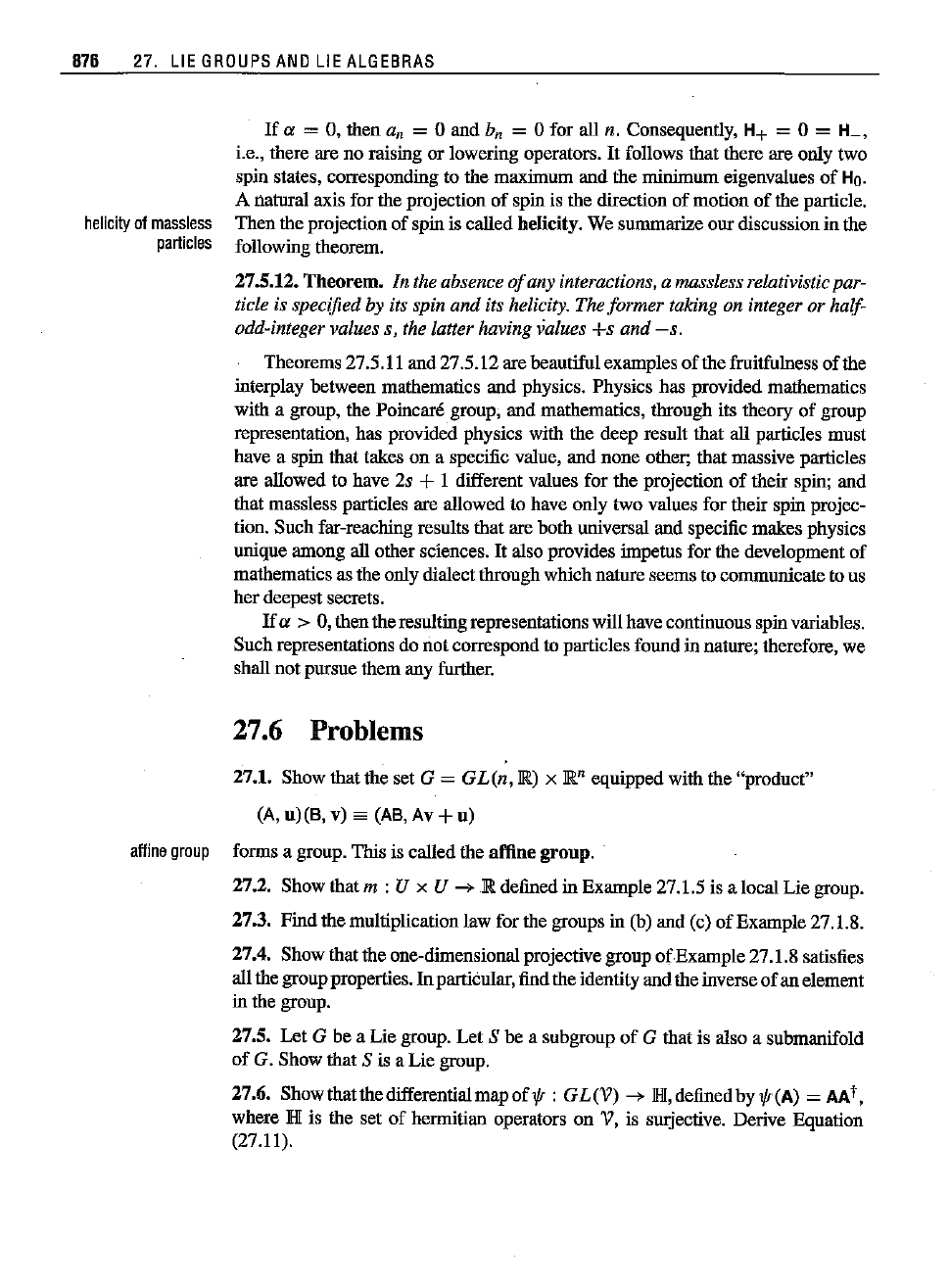
876 27. LIE
GROUPS
AND
LIE
ALGEBRAS
helicity
of
massless
particles
If
ex
= 0, then an = 0 and b
n
= 0 for all n, Consequently, H+ = 0 = H_,
i.e., there are no raising or lowering operators.
It
follows that there are only two
spin states, corresponding to the maximum and the minimum eigenvalues
of
Ho.
A natural axis for the projection of spin is the direction of motion
of
the particle.
Then the projection of spin is called helicity. We summarize our discussion in the
following theorem.
27.5.12.
Theorem.
In the absence
of
any interactions, a massless relativistic par-
ticle is specified by its spin
and
its helicity. The former taking on integer or half-
odd-integer values s, the latter having values
+s
and
-s.
Theorems 27.5.11 and 27.5.12 are beautifulexamples
of
the fruitfulness of the
interplay between mathematics and physics. Physics has provided mathematics
with a group, the Poincare group, and mathematics, through its theory of group
representation, has provided physics with the deep result that all particles must
have a spin that takes on a specific value, and none other; that massive particles
are allowed to have 2s
+ I different values for the projection
of
their spin; and
that massless particles are allowed to have only two values for their spin projec-
tion. Such far-reaching resnlts that are both universal and specific makes physics
unique among all other sciences.
It
also provides impetus for the development of
mathematics as the only dialect through which nature seems to communicateto us
her deepest secrets.
If
ex
> 0, then the resnltingrepresentations will have continuous spin variables.
Such representations do not correspond to particles found in nature; therefore, we
shall not pursue them any further.
27.6 Problems
27.1. Show that the set G =
GL(n,~)
x
~n
equipped with the "product"
(A,u)(B, v) sa
(AB,
Av+u)
affine
group
forms a group. This is called the affine group.
27.2. Show that m : U x U -->
~
defined in Example 27.1.5 is a local Lie group.
27.3. Find the multiplication law for the groups in (b) and (c) of Example 27.1.8.
27.4. Show that the one-dimensional projective group
of
Example27.1.8 satisfies
all the group properties.In particnlar, find the identityand the inverse
of
an element
in the group.
27.5.
Let
G be a Lie group. Let S be a subgroup
of
G that is also a submanifold
of G. Show that S is a Lie group.
27.6. Show thatthc differentialmap
of
v :
GL(V)
-->
IHI,
defined by
lfr(A)
= AAt,
where
IHI
is the set of hermitian operators on V, is surjective. Derive Equation
(27.11).

27.6
PROBLEMS
877
27.7. Verify that
19
sa R
g
'
0 L
g
is an isomorphism.
27.8. Prove Proposition 27.1.21.
27.9. Start with Equation (27.19) and use the fact that second derivative is inde-
pendent of the order of differentiation to obtain
Now use the chain rule
aUiKjaa" =
(aUiKjaXj}(aXj
jaa,,)
and Equation (27.19)
to get
or
(27.76)
where
Substituting Equation (27.76) in Equation (27.21) leads to (27.22). Now differen-
tiate both sides of Equation (27.76)
withrespectto
a
p
to get
ac~u
-a-UiK
=0.
up
With the assumption that the
UiK
are linearlyindependent, concludethat the struc-
ture
"constants"
areindeed
constants.
27.10. Find the invariant Haar measure
of
the general linear group in two dimen-
sions.
27.11. Show that the invariant
Haar
measure for a compactgroup satisfies
dp
g
=
dprl.
Hint: Define ameasure
vby
dV
g
==
dprl
andshowthatvisleft-invariant.
Now use the uniqueness of the left-invariant Haar measure for compact groups.
27.12. Show that
O(p,
n -
p}
is a group. Use this and the fact that
'7-
1
= '7 to
show that
A'7
A'
= '7.
27.13. Show that the orthogonal group
O(p,
n -
p}
has dimension n(n -
l}j2.
Hint: Look at its algebra
o(p,
n -
pl.
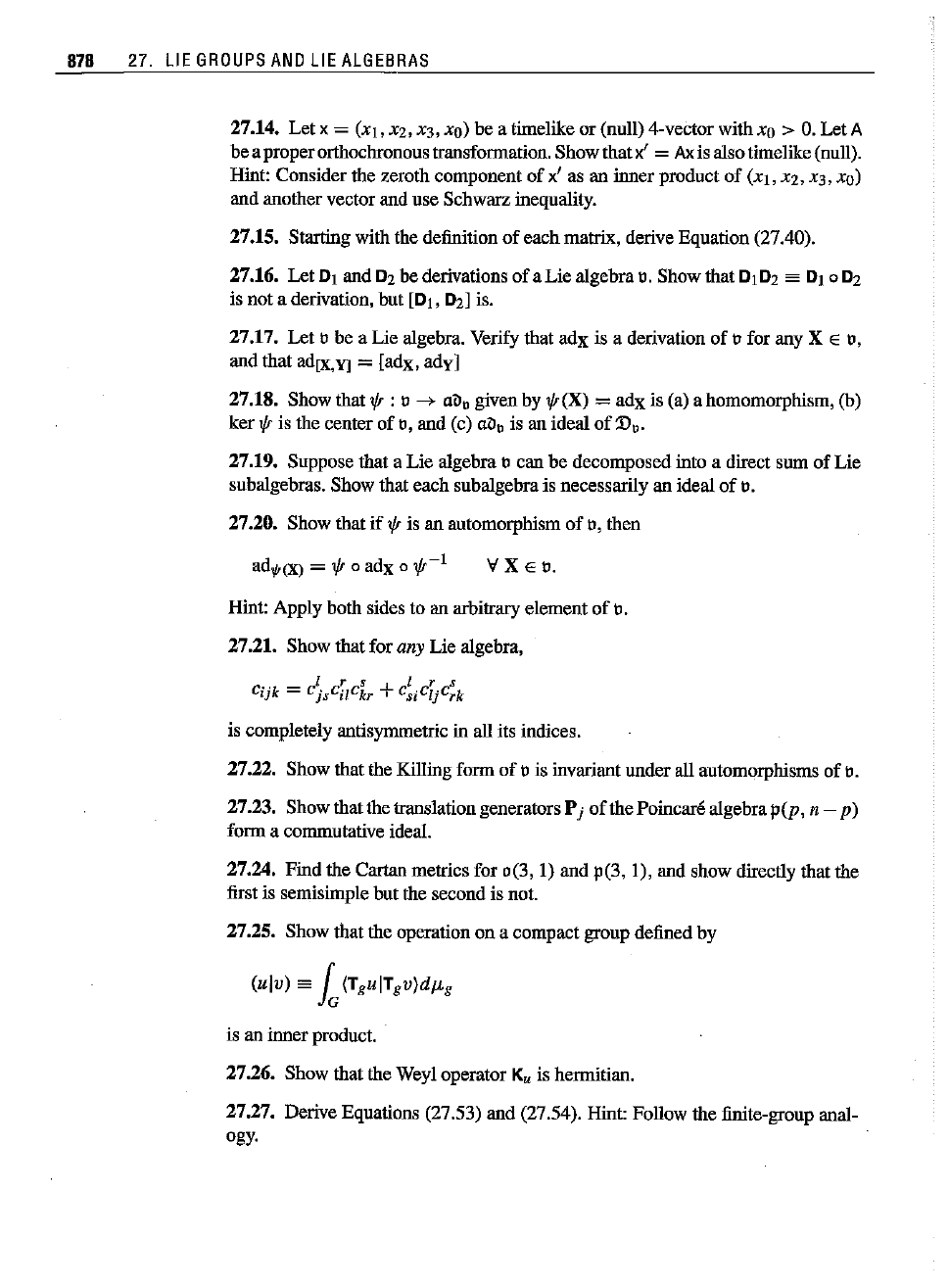
878 27. LIE
GROUPS
AND
LIE
ALGEBRAS
27.14. Let x = (Xj,
X2,
x3, xo) be a timelike or (null) 4-vector withxo >
O.
LetA
be aproperorthocbronoustransformation. Showthatx' = Axis also timelike (null).
Hint: Consider the zeroth component of x' as an inner product of
(Xj, X2,
X3,
xo)
and another vector and use Schwarz inequality.
27.15. Starting with the definition
of
eachmatrix, derive Equation (27.40).
27.16. Let OJ and 02 be derivations of a Lie algebra u, Show that
Oj02
es OJ
002
is not a derivation, but [OJ, 02] is.
27.17. Let u be a Lie algebra. Verify that
adx
is a derivatiou of Ufor any X E
U,
and that adrx,Yl = [adx, adv]
27.18. Show that
1fr
: U
-+
aD.
given by
1fr(X)
=
adx
is (a) a homomorphism, (b)
ker
1fr
is the center of n, and (c)
aD.
is an ideal
of
:De-
27.19. Suppose that a Lie algebra Ucan be decomposed into a direct sum of Lie
subalgebras. Show that each subalgebra is necessarily an ideal
of
e.
27.20. Show that
if
1fr
is an automorphism of n, then
ad,,(x)
=
1fr
0 adx 0
1fr-
j
VXEU.
Hint: Apply both sides to an arbitrary element
of
e.
27.21. Show that for any Lie algebra,
is completely antisymmetric in
all its indices.
27.22. Show that the Killing form
of
Uis invariant under all automorphisms of n,
27.23. Show that the translation generators Pj
of
the poincarealgebra p(p, n - p)
form a commutative ideal.
27.24. Find the Carlan metrics for 0(3, 1) and p(3, 1), and show directly that the
first is semisimple but the second is not.
27.25. Show that the operation on a compact group defined by
(ulv)
==
fa
{TguITgv)dJLg
is an
inner
product.
27.26. Show that the Weyl operator K
u
is hermitian.
27.27. Derive Equations (27.53) and (27.54). Hint: Follow the finite-group anal-
ogy.
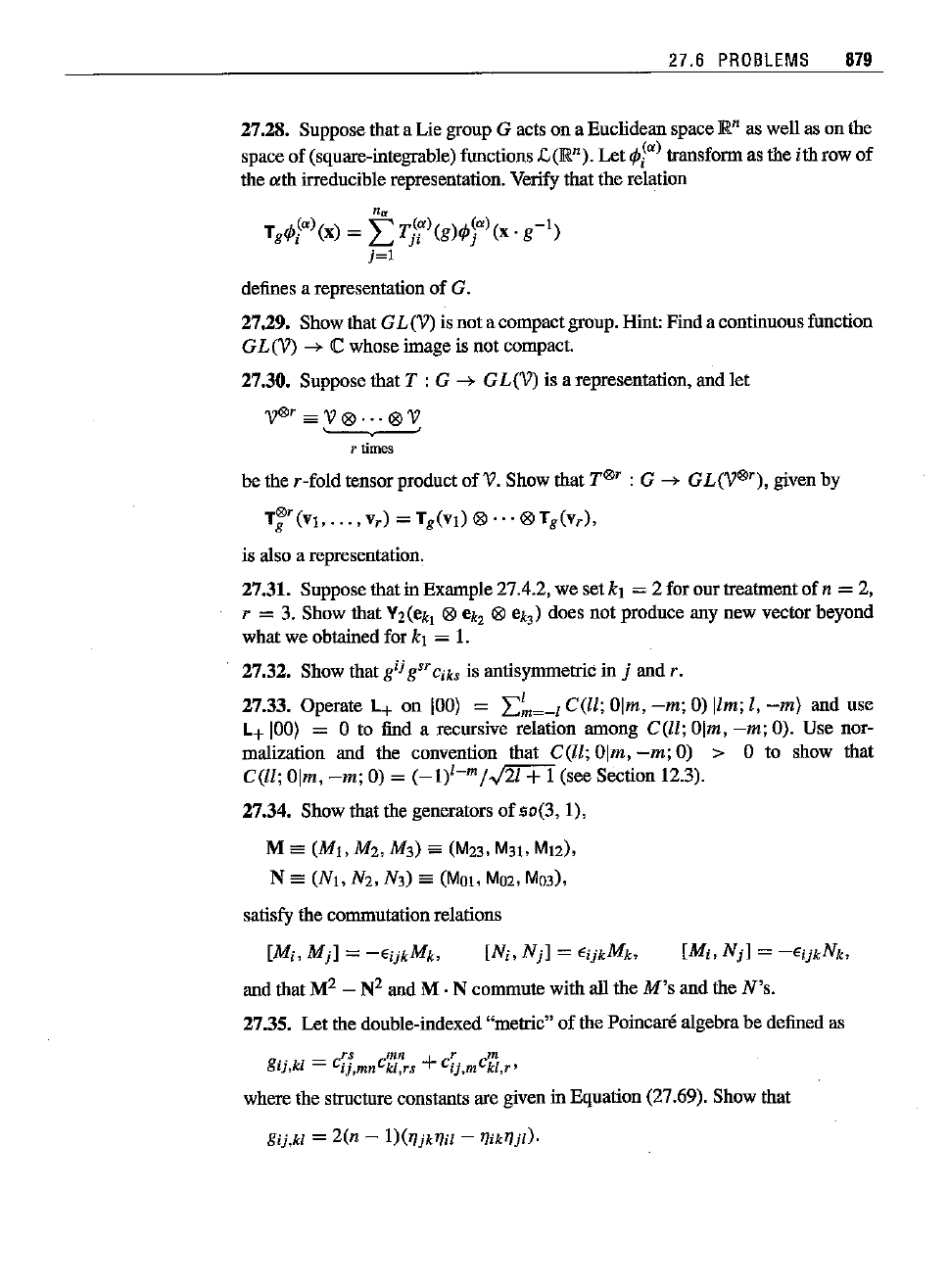
27.6
PROBLEMS
879
27.28. Supposethata Lie group G acts
on
a
Euclidean
space
JRn
as well as on the
space
of
(square-integrable) functions
,c(JR
n).
Let
¢!.)
transformas
the
ithrow
of
the oth irreducible representation. Verify that
the
relation
n
a
Tg¢i(·)(X) =
LTj~·)(g)¢j·)(x.
g-I)
j~1
defines a representation
of
G.
27.29. ShowthatG
L(V)
is
not
a
compact
group. Hint:
Find
a continuousfunction
GL (V) --> C whose image is
not
compact.
27.30. Suppose that T : G --> G
L(V)
is a representation,
and
let
v®r
==V<8l
...
<8lV
r times
be
the
r-fold
tensor product
ofV.
Show that T®r : G -->
GL(v®r),
given by
T~r
(VI,
...
, v
r
)
= Tg(VI)
<8l
...
<8l
T
g
(v
r),
is also a
representation.
27.31. Suppose thatin Example 27.4.2,we set kl =2 for
our
treatment
of
n =2,
r = 3. Show that Yz(ek,
<8l
ek,
<8l
ek,)
does
not
produce any
new
vector
beyond
what
we obtained for kl = 1.
27.32. Show that
gij
g"
Ciks is antisymmetric in j and r,
27.33. Operate L+
on
100)
=
L:~~-l
C(ll;
Dim,
-m;
0)
11m;
I,
-m)
and
use
L+
100)
= 0 to find a recursive relation
among
C(ll;
Dim,
-m;
0).
Use nor-
malization and the convention that
C(ll;
Dim,
-m;
0) > 0 to show that
C(ll;
Dim,
-m;
0) =
(-li-
m
/
'/
21+I (see Section 12.3).
27.34.
Show that the generators
of
so(3, I),
M
==
(MI,
Mz,
M3)
==
(MZ3,
M31,
MIZ),
N
==
(NI,
Ns,
N3) ea
(MOl,
Moz,
MQ3),
satisfy the commutation relations
[Mi,
Mjl
=
-EijkMk,
[Ni,
Njl
= EijkMko
[Mi,
Njl
=
-EijkNk,
and that M
Z
-
N
Z
and M . N commute with all
the
M's
and
the N's.
27.35.
Let
the double-indexed
"metric"
of
the Poincare algebra be defined as
rs mn + r m
gij,kl
= Cij,mnCkl,rs Cij,mGkl,r'
where the structure constants are given in
Equation
(27.69).Show that
gij,kl =
2(n
- I)(ryjkryi/ -
nonn).
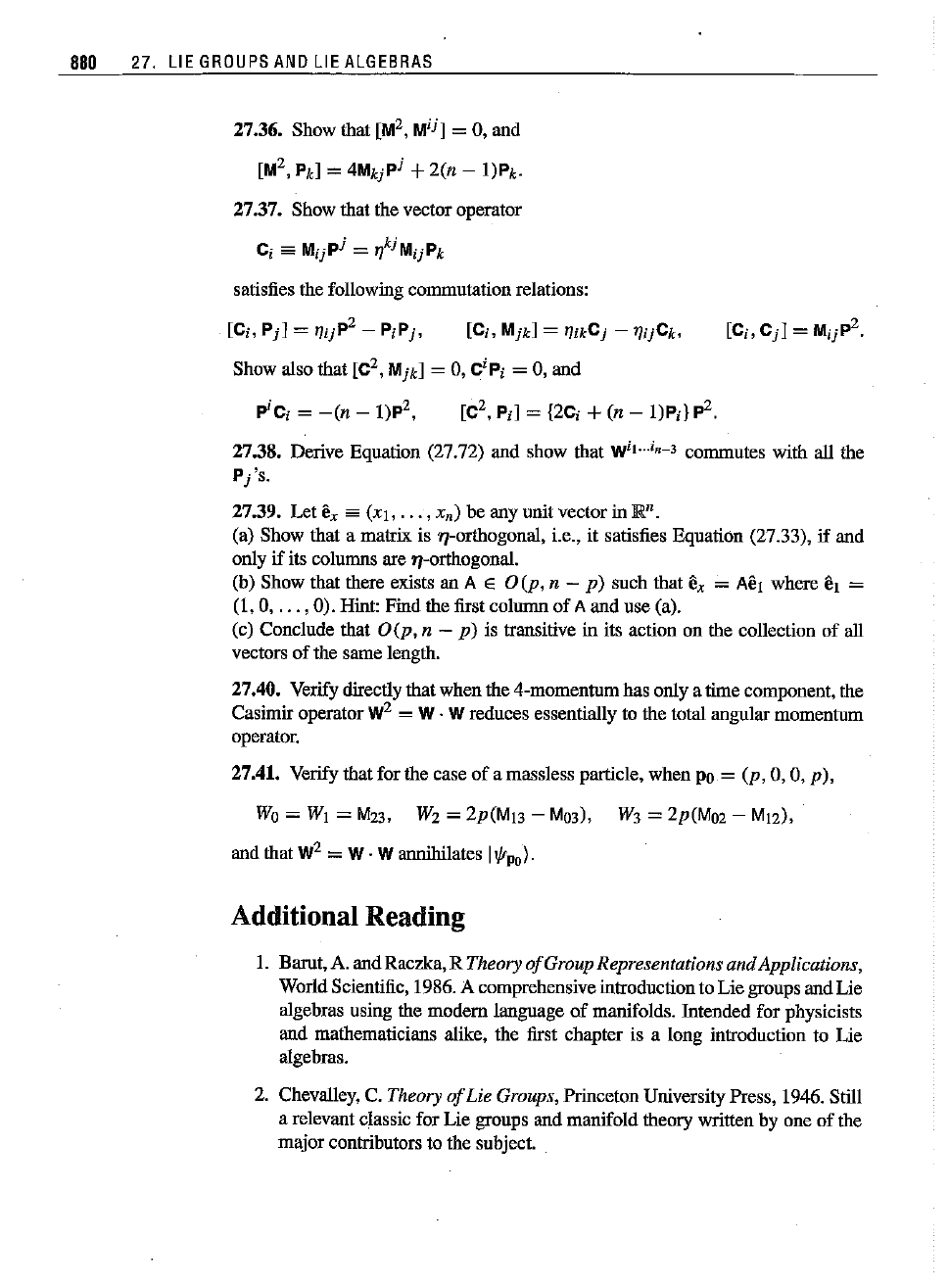
880 27. LIE
GROUPS
AND LIE
ALGEBRAS
27.36. Show that [M
2,
Mijj = 0, and
[M
2
,
Pk] = 4MkjPj +2(n - I)Pk·
27.37. Show that the vector operator
. ki
Ci
==
MijPJ = n
JMijPk
satisfies the following commutation relations:
Show also that [C
2
,
Mjk]
=0,
CiPi
= 0, and
piCi =
-(n
_I)P
2
,
[C
2
,
Pil = {2Ci +(n
-I)P;Jp
2
.
27.38. Derive Equation (27.72) and show that w
i
,...i"-3 commutes with all the
Pj's.
27.39. Let ex sa (Xl,
...
, x
n)
be any unit vector in
JRn.
(a) Show that a matrix is '1/-orthogoual, i.e., it satisfies Equation (27.33),
if
and
only
if
its colunms are '1/-orthogoual.
(b) Show that there exists an A E
O(p,
n -
p)
such that ex = Ael where e\ =
(1,0,
...
,0).
Hint: Find the first colunm of Aand use (a).
(c) Couclude that 0
(p,
n -
p)
is transitive in its action on the collection of all
vectors of the same length.
27.40. Verify directly that when the 4-momentum has only a time component, the
Casimir operator
W
2
= W . W reduces essentially to the total angularmomentum
operator.
27.41. Verify that for the case
of
a massless particle, when Po =
(p,
0, 0,
p),
Wo = WI =
M23,
W2 = 2p(M13 - M03), W3 = 2p(M02 -
M12),
and that W
2
=
W·
W annihilates
l1fJ
po
)'
Additional Reading
1. Barut, A. and Raczka, R Theory
of
Group Representations
and
Applications,
World Scientific, 1986. A comprehensiveintroductionto Lie groups and Lie
algebras using the modem language
of
manifolds. lutended for physicists
and mathematicians alike, the first chapter is a long introduction to Lie
algebras.
2. Chevalley, C.
Theory
of
Lie Groups, Princeton University Press, 1946. Still
a relevant classic for Lie groups and manifold theory written by one of the
major contributors to the subject.
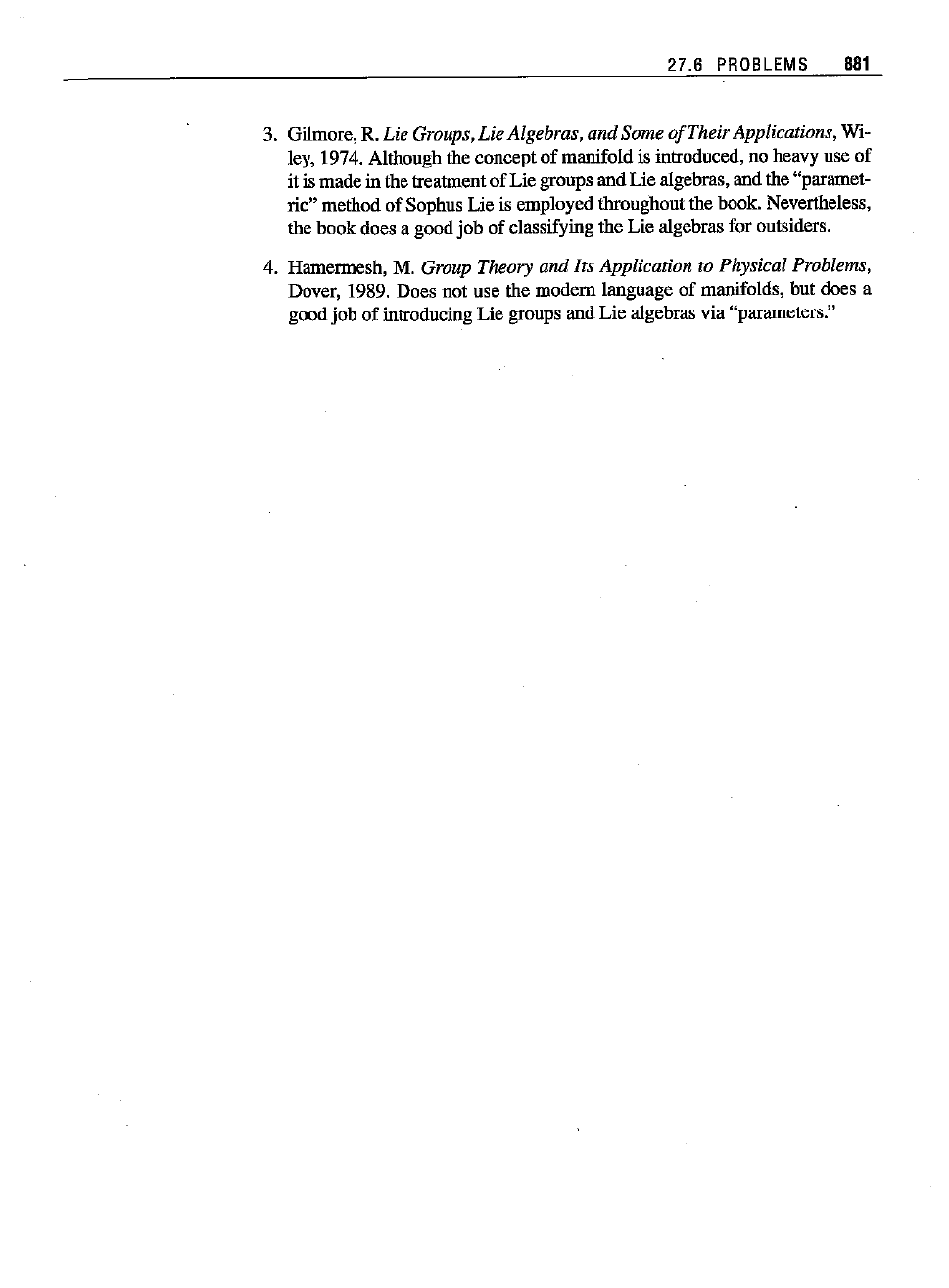
27.6
PROBLEMS
881
3. Gilmore, R. Lie Groups,Lie Algebras, and Some
of
TheirApplications,Wi-
ley, 1974. Although the concept
of
manifold is introduced, no heavy use of
it is made in the treatment
of
Lie groups and Lie algebras, and the "paramet-
ric" method of Sophus Lie is employed throughout the book. Nevertheless,
the book does a good
job
of classifying the Lie algebras for outsiders.
4. Hamermesh, M.
Group Theory and Its Application to Physical Problems,
Dover, 1989. Does not use the modem language of manifolds, but does a
good job of introducing Lie groups and Lie algebras via "parameters."

28 _
Differential Geometry
The elegance
of
the geometrical expression
of
physical ideas has attracted mnch
attention ever since Einstein proposed his geometrical theory of gravity in 1916.
Such an interpretation was, however, confined to the general theory
of
relativity
until the 1970s when the language of geometry was found to be most suitable, not
only for gravity, butalso for the otherthree fundamentalforces ofnature. Geometry,
in the form of gauge field theories of electroweakand strong interactions, has been
successful not only in creating a
model-the
so-called standard
model-that
explains all experimental results to remarkable accuracy, but also in providing
a common language for describing all fundamental forces of nature, and with
that a hope for unifying these forces into a single all-embracing force. This hope
is encouraged by the successful unification of electromagnetism with the weak
nuclear force through the medimn
of
geometry and gauge field theory.
The word "geometry"is normallyused in the mathematics literature for a man-
ifold on which a "machine"is defined with the property that it gives
anmnber
when
two vectors are fed into it. Symplectic geometry's machine was a nondegenerate
2-form. Riemannian (or pseudo-Riemannian) geometry has a symmetric bilinear
form (metric, inner product). Both of these geometries are important: Symplectic
geometry is the natural setring for Hamiltonian dynamics, and Riemannian geom-
etry is the basis of the general theory
of
relativity.
In
this chapter, we shall study
the latter.
1
However, before introducing the metric, let us investigate some related
structures that are independent of a metric.
IThis
chapter
reallybelongstothe
previous
part
of the
book;
however,
becauseof ouruseof
certain
Lie-group
theoretic
ideas
inSections28.4 and28.6, we have
included
it
here.
